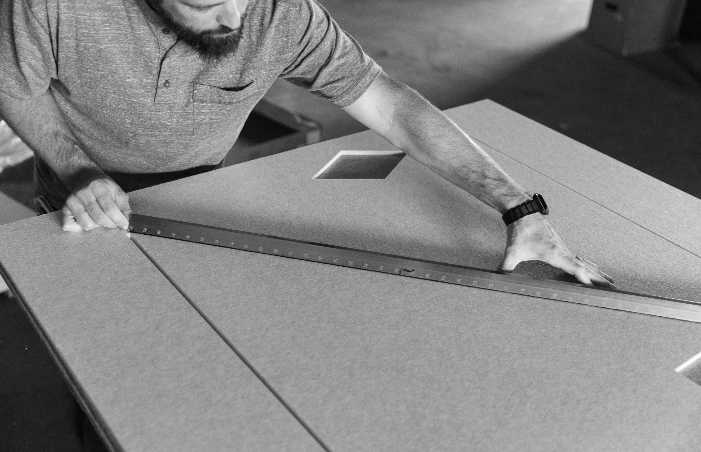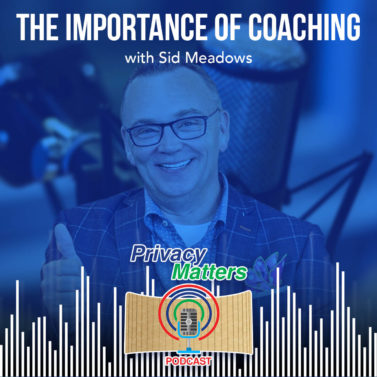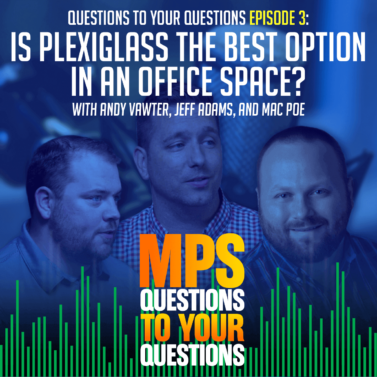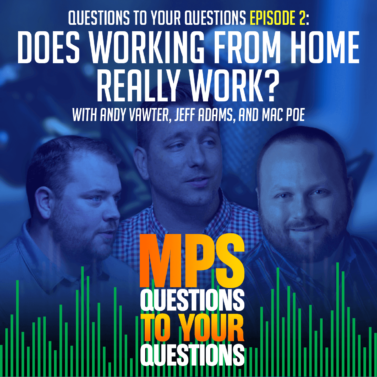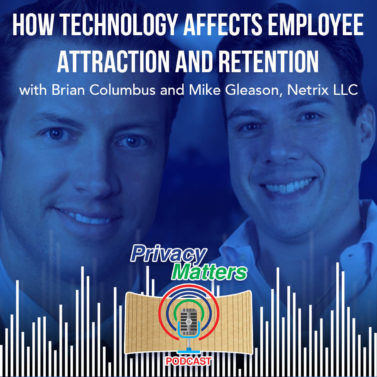Andy [00:16]:
In today’s episode of the podcast, I was interviewed by Sid Meadows on his podcast, The Trend Report. We really wanted to talk about how to build a team and what we’ve learned here at MPS, in building a team over the years. It was a great conversation. I learned a lot and hopefully you’ll learn a lot too.
Sid [00:36]:
Hey, everybody. Welcome to this week’s episode of The Trend Report Podcast. I’m really glad you’re here with me today for this conversation with my guest today. Andy Vawter. Hey Andy, how are you?
Andy [00:45]:
I am well, thanks for having me.
Sid [00:47]:
I’m glad that you’re here. So as we get started, why don’t you tell our audience who you are and what you do, and the company you work for.
Andy [00:55]:
Sure. My name is Andy Vawter. I work for a company called MPS. We’re an acoustics company, so we solve acoustical problems by using space partitions, absorbing material or sound masking, electronic white noise systems, all those things. And we work with the contract furniture industry, A&D industry and architects and designers and things like that. We have really made it in our DNA to be someone that solves problems. We really want to be known as the company that you go to if you have a problem and you need a sound or acoustic or noise problem when you need help. And we can come up with solutions and we can turn the key in and make it easy for you. MPS stands for Making Privacy Simple. So our DNA is responsive, fast, easy, and all the things that we hear can be a challenge. We want to take that burden on ourselves and make it easy for our partners and our customers.
Sid [01:55]:
Sure. So I appreciate that introduction and actually Andy and I are on our onsite together actually recording this in person, which is the first time I’ve actually done this in a while. So I’m glad to be here with you. And I’m excited to actually get a tour and learn more about the products that you sell, but you guys recently did a brand change, right?
Andy [02:17]:
Yeah, we did.
Sid [02:17]:
And so what was that experience like?
Andy [02:20]:
Oh, I would not recommend it. I would just say that. We did a brand complete name change, and we actually shut down the other company as an LLC and stated a new LLC. There were a lot of reasons for that, that attorneys explained that I’m not going to try and explain. So we were Speech Privacy Systems and we switched to MPS. And the main reason for that was we kept adding, expanding into different markets, into different vertical markets, different product lines, different market strategies. And we felt like the name that people knew us as was extremely narrow. And we were designed for SEO. I mean, that’s why we called ourselves that years ago. And we were like, we need it to be a little bit more nonspecific. And so we felt like MPS made a lot of sense because it stands for something that we believe in. But it also is just three letters, which stands for nothing in the end, which means you can be whatever you need to be. And so that was kind of the aha moment for us.
Sid [03:23]:
We fit in perfectly in our industry, because you use an acronym, and we love acronyms. So in your role here, you lead the sales and the operations side of the business. (Andy: I do. Yeah.) So a lot of time you’re spending out in the field working with what would make it get into the field, right. Working with your independent reps, with the dealer, community, and users, and then you’re also supporting your team internally, whether it’s engineers and production and customer service and all those things.
Andy [03:53]:
All right. All of it. Yeah. Yeah.
Sid [03:56]:
Having a cohesive united team and a team that works well together, tell me what’s it like building that?
Andy [04:05]:
That’s a great question. Well, to kind of back up to that I originally came from the sales team but I just am very hands-on with a lot of things. I really have no manufacturing experience, which is kind of funny, but even though I’m the head of manufacturing. But the reason I took this position and we kind of morphed into me, it was like I said, our DNA especially on the sales team was customer service, quick response. We really care about making things easy and simple for people. And but as we grew and we’ve grown pretty rapidly since I’ve been here our operations team got more process-driven. We started off, like, I could literally make the order happen. I could sign off, I could walk back and pack the box and make sure it went out that day. But as we grew, we started to add layers of complexity as often happens. And our operations side was getting more and more, which was a great thing. We were getting more processes and getting more driven by that. But what was happening was, in my opinion, and in Bruce Davidson, our CEO’s opinion, we were getting a little bit too rigid on processes and missing what was selling. Like the reason, customers came to us. And so without messing everything up on the process side, my goal is to bring everybody back together and understand why people work with us, why they choose us over other people. And then how do we keep that all about us throughout the organization? So if you’re the shipping guy, of course, you have to have the right information. And of course, it’s important to have the process followed. But the number one thing that’s important is our customers happy. So how do we marry those two things? And so that’s what I’ve been trying to do with the team, both building new people into the team and just really trying to create a culture that I don’t care what your position is. You’re a salesperson or organization. Your job is to take care of our customers. And it’s whether you’re returning equipment, shipping equipment, producing equipment, invoicing all those things are selling activities because people work in this cause we make things easy.
Sid [06:19]:
Listen, I could not agree with you more. Every person inside an organization is in sales in some way. And I know I hear it all the time. Oh, I hate sales and I want to be a salesperson. If you’re a customer service person, you’re in sales. If you’re in shipping, you’re in sales. If you’re an installation, you’re in sales, because the experience that you offer that customer gives them the insight of whether they want to come back and do business with you again. And I honestly have always said this, what are the single most important people in the entire sales process is the installer because the installer gives the customer the last experience before the next opportunity.
Andy [06:58]:
Yeah, that’s right. No, that’s all right. So last year we did installations all over the country. We use subcontractors because it would be impossible to do that effectively without it. But last year we invested heavily in hiring for direct employees who are all OSHA certified and then highly trained in our products. And they mostly stick to Texas, but they’ll travel anywhere to keep their schedules full and for the right type of job. But the goal there was, we were sitting around saying that exact thing you just said, the last experience people have with our company is that person handing off product to them. And I want them to have an MPS logo shirt and a business card that says, look, if there’s any issues, here’s my cell call me, cause I installed this and I will fix it. You know, we knew that if that experience goes above and beyond what they get everywhere else that they’re going to call us again. They’re going to want to work with us again. And so we made that investment and we’ve seen it pay off tremendously. We’re not quite ready to have like a hundred but it’s allowed us to, especially where more important higher-profile projects. We can get our employees on and make sure that they go off without a hitch. And that’s been absolutely monumental for our business side.
Sid [08:19]:
Well, it sounds to me that in addition to really focusing on building your team, you’ve also been focusing on the customer experience. (Andy: Absolutely.) So do you have a customer experience manager in your organization?
Andy [08:30]:
No. No, we don’t. I don’t think we’re quite big enough to have that yet it would be the thing, but it is certainly something that both our marketing and our sales support. I would say where we really hit home is that as we hired another layer of sales support, people which are customer service. They work with our sales team, but they’re very dedicated and their KPIs are basically all-around customer satisfaction and speed of response and things like that. Allowing our sales team to then focus more on high-level conversations and closing sales. Now, we have somebody behind them that can make sure that we come through on all those things. But it’s a high focus point for us at this point.
Sid [09:17]:
Well, you set up as part of your culture, customer experience as being one of the big drivers, right. And you put people and resources in place to ensure that happens. Yeah. So whether you want to add it to your job title or not, you’re the customer experience manager and you’re driving that culture to the team and making sure everybody understands the importance of that.
Andy [09:36]:
When you talk about building a team, we use personality profiles, a company called culture index where we screen applicants based on first and foremost, we want the type of person who has the right attributes for that to be screened out originally. Like if a great example of that is we only hire a couple of different profiles for salespeople. And it’s because a lot of people do not have the personal traits, intrinsic traits in their nature to be a good salesperson. It doesn’t mean they can’t get better or learn, but just let’s start a little. It’s called culture index. It’s fantastic. So this is how they sold it to us. It’s a six-minute questionnaire. You just take it, you answer some quick questions. It’s very easy. It’s like a disc. But man, where they nailed me and I’ve taken a desk and I’ve done all that kind of describes me. I’m a complicated person. Anyway. It always hits me there. So this is how they sold to us. They bring a bunch of us to a conference room and the gentleman pulls up a stack of papers and he flips through them and he says, Andy Vawter, where’s my hat. I’ve never met this guy. When he talks, this is what he actually means and you never want to go to Andy like this and the whole place is laughing. Everybody’s dying. Cause he is pinning me up against the wall and he did that to me. And he’s like, all right, well John, John is John. Okay, John? And he nailed everybody in the room. Wow.
Sid [11:05]:
Off of a six-minute test.
Andy [11:07]:
And he’s like, look, I can’t tell you what your motivations are. I can’t tell you what your ethics are. It’s not foolproof there. It doesn’t mean you’re going to be a hard worker. It doesn’t mean you’re going to be a good person, but I can tell you what drives you or like, are you internally motivated or externally motivated? Are you detailed or not? Are you personable or not? And to what degree? And it was just hilarious. We’ve used that to help us. It’s not foolproof, but man, it sure helps get you. If you know what type of person you need to fulfill these roles, then you know, you can at least screen applicants that fit those profiles. And then you interview based on that.
Sid [11:46]:
So do you share those results with other team members? So what’s the impact of that?
Andy [11:51]:
I think it helps us communicate. People know based on my profile, but I am very single-focused, so whatever I’m doing, that’s what I’m doing. People have learned that if I’m typing an email and they walk into my office and start talking and I’m not looking at them, they might as well be talking to the wall because I didn’t even know they were talking yet. We’ve helped explain, I’m not being rude. That’s just how I am. And so, but it helps people that communicate better. Now they’re like, hold on, I need your eyes. So I got to close my laptop and slide my chair over.
Sid [12:26]:
So basically you’ve used it as a way to help your teamwork to get better together.
Andy [12:32]:
Yes. So the idea was get the right people in the right seat and then help them work better together. Help them leverage each other’s strengths and weaknesses.
Sid [12:39]:
So as the person that’s investing in that and taking those steps to do that, what would you say has been the impact on your organization?
Andy [12:47]:
I think it’s helped us get the right people. That’s only a portion of it when we first got it. We thought it was the Bible. And so we only hired off of that and we failed miserably. It’s like, you’re supposed to be like this, like, Oh, well, you know, you’re lazy. It turns out. And so the more we understood some more of the nuance of it, it’s a great tool to help you get down the right path, but great accountability and goal-oriented, oriented beginnings to a job, onboarding a 60-day onboarding. We went through a lot of processes of figuring it out. When I was hired it was like, all right, so here’s your office, here’s your computer. You’re going to shadow this person for a couple hours. I made it through all right, but most we failed a lot because we didn’t onboard people properly. So then we focused on that and said, how do we bring people in with a plan and accountability plan? They know what they’re being measured on in the interview process. We’re hiring you to sell this much, or we’re hiring you to improve this aspect of this point. So it’s no surprise 90 days in, if you’re not trending towards that, you already know that you’re not quite meeting up to the standard. And so all those things together, I think we started to learn, okay, it’s never foolproof, right. But we started having a higher batting average and better employee retainage and less turnover in a 12 month period. I think that’s been the ultimate result of getting the right people is there’s more security or more predictability and structure.
Sid [14:33]:
I love the fact that you put together a 60-day onboarding program to put everybody through the same thing.
Andy [14:40]:
We tailor it to their position. But we learned that you can plan somebody’s day out 60 days from their first day of hire and you know, but by the back end. It’s like, you’re only going to have these two daily meetings that are going to be an hour-long, but the rest of the day is work, start doing your job. So you start with the first two weeks, you don’t have any control over your time. You’re always with somebody. And then we start to transition away from that. But we found that that works a lot better than you’re hired. We’re going to shadow a couple of days and then good luck. And that just that start drop-off seemed to fail a lot of people. And what I’ve learned is its certain types of people through no fault of their own. There’s just some personality profiles that they need a different type of onboarding. They could be better than everybody else if you onboard them.
Sid [15:34]:
Right. So you’re also adjusting it as you need it.
Andy [15:37]:
Absolutely. Yeah. It’s just some people very quickly show you. Like, no, I don’t need all that. Just some people are like, give me the result that you want and leave me alone. I’m kind of that way. But don’t mess with me, just tell me what you want. And I’ll figure it out. I’ll do it. Other people where they think you’ve abandoned them and you’re going to walk in and fire them any day. Cause you haven’t talked to them and you know, it was four hours.
Sid [15:59]:
What you’re saying is and what I’m hearing is you can’t manage everyone exactly the same way because people are different and you need to be able to understand who they are by a personality profile to assess them. You need to give them a process of which they can be successful, but you need to really understand how they work in order to tailor it and tailor how you lead them in order to lead them to the right level of success for your organization.
Andy [16:28]:
Absolutely. And you know, that’s not to say you play favorites or we hold everybody accountable to a standard that we feel is important, but everybody’s different. I have to learn it. I’m a former football coach. So I mean, it was the same thing. If I’m coaching the quarterback versus the running back, those are different people and they’re thinking about different things. I think I learned at a pretty young age as a young adult how to do some of those things, but I try to apply that sharing with the team. I have to treat different people differently. A great example is one of our sales guys is a former football player of mine. Because since he was 16, I don’t do that to everybody else because the relationship is different and they respond differently. But in the end, we’re here to perform. We’re here to do a job well and get a certain outcome that we each are responsible for. And so I try to keep the focus on the outcome. What happens between here and there is a lot more up to that person.
Sid [17:44]:
But it also sounds like to me that the outcome is established and they know.
Andy [17:48]:
It has to be. And that’s something we failed that more than we succeeded at. We didn’t just read a book and like, all right, good. Let’s implement that. We failed. And we failed and we failed. And we started just realizing like I knew what their outcomes were and I hadn’t communicated that to them. So they didn’t know if they were failing or successful. And so we sit down and say, I don’t think this is working. I think, you know, you got to look for another job and they’re completely surprised assuming that they were doing so well. And I’m like, that’s my fault. That was on me. I didn’t do a good job of that. So almost everything I’ve learned how to do, right. I’ve learned by doing it wrong, I think every possible way again.
Sid [18:29]:
So this is great because I have this philosophy about success and failure. And actually, I don’t believe there’s any such thing as failure. I believe there’s only learning opportunities. And so I was actually working with a client outside of our industry and he’s a big burly guy, football player. He’s just one of my most favorite clients. We start talking about success and failure and he goes, well, there’s only success and there’s only failure. And so I challenged him on that and it was a very interesting conversation, but where I got him to change his thought process around it was asking for questions. Rather than looking at something that the outcome wasn’t what you wanted is failure. Let’s look at what we can learn from that outcome. So I gave him a series of four questions to ask, which I think are really powerful questions because, in anything that you do when you don’t get the desired outcome, it doesn’t mean it wasn’t successful. You just didn’t get the outcome that you wanted. Right. So the four questions are, what went right? Because something always goes right. What went wrong? Because if you didn’t get the outcome you wanted something didn’t go right. So what went wrong? The third question, which is probably the most important one is what did you learn? What did you learn from the experience and the fourth one, which I guess it could be argued. It could be the most important too is what are you gonna do differently than next? How are you going to change and adapt in order to get a different result? And that can be applied in any job, in any function, sales, non-sales, whatever it is to really learn from the experience and in your personal life too, for that matter. So learn from what you went through.
Andy [20:14]:
One of the ways I describe it to pretty much everybody when we talk about things like this is, you know, my goal is to be better today than I was yesterday. It’s never perfect because we know that I can’t be and if I fail well, then that just sets the bar down, and then tomorrow, can I be better? It’s not this perfect curve. It’s just a constant struggle to improve. Failure is simply just an opportunity then tomorrow to do something a little bit better or different. COVID has been a great example of that. What we thought in May, in April or March has changed. And even what we thought this summer is changing again, then we know it’s going to change again. Not being, so this is how we’re going to do it and this is the outcome that we must have because we assume, well, we’re going to sell millions here doing this, and then it doesn’t happen. And we’re like, where we just wrong or did things change? Or what can we learn from that? And what did we do right? I would say some of the things that I’ve been praising our team about was we launched a new website and three new product lines in the middle of quarantine in the March, April timeframe. I mean, it was amazing that we were initiatives we were trying to get done. For months we could not, we were too busy just in the day-to-day to get these strategic things accomplished. And we started doing daily sales and marketing Zoom calls together. We stopped doing them daily that got a little out of hand, but when things were changing daily, that was really helpful. Because we would sit down the sales team say, man, I had a dozen calls today and this happened, and now the marketing team can take that and say, okay, well we need to shift our communication. And so I was really proud of how we failed all through COVID, but we came through on a couple of things that I think really showed that we had, first of all, the right team, we had people that really knew how to come through in a time that was really challenging come together and then solve problems as a team and let their creativity come alive. That was extremely exciting to see throughout it. It doesn’t mean we had a ton of success necessarily. I don’t know other than Amazon and Lowe’s who did right. But I really solidified with me that the team we have is people that really care about success and want to think about how they can be better.
Sid [22:50]:
Well, it sounds like to me that you took advantage of a difficult situation, right? Launching 40 products, you pulled your team together, you’re having daily calls and you adjusted to not daily calls, but you are successful in launching four new products during basically a worldwide shutdown and your team rallied and pulled together. I think what I heard you say is if things had continued, you probably wouldn’t have gotten it done. That COVID allowed for the focus to get it done. You take advantage.
Andy [23:18]:
Even financially. We were doing really well. I am on pace for record just like everybody else wasn’t sure and then COVID changed that right. So now we’re backwards, but the things that we’ve learned internally, financially, budget-wise, and spending wise is going to position us so much better for the future than going into this. And so I’m grateful for that. It wasn’t roses this is not how I would have chosen some of these things to happen. But I look at it and say, well, these are opportunities for us to be better. And I believe in most cases, we rose to the challenge of that.
Sid [23:57]:
And that’s great because I think there’s so many people that didn’t, and there are a lot of people that aren’t really thinking forward like that. So kudos to you for doing that and realizing what you needed to do during this time in order to come out on the other side better. Cause there is another side when it’s going to be. We all agree that our industry is going to be different, but you’re thinking forward enough to try to figure it out.
Andy [24:20]:
Well, we started this year, we went to quarterly goals and we used to do yearly goals and scrap that and so we’re doing quarterly. Well, then the first quarter kind of ended kind of crazily. When we hit our first-quarter goal, I didn’t know what to do for the second quarter. I know nothing. Our goal for the second quarter was everybody come up with two ways that you can improve and I’ll survey you. So I surveyed them and they all gave me two ways they could prove. So then I could follow up and say, did you do that right? Do you want to learn Excel better? Or do you want to learn this? It was just one of those things where I was sitting there. I don’t want to lose this momentum we’ve built on these more predictable quarterly conversations, but I have absolutely no idea what Q2 is going to look like and Q3 and Q4. No idea. But we’re trying to be creative about those types of things. At some point we’re going to get back to where we can start looking at our pipeline and say, Hey, this is where we’re trying to hit. It just kinda goes back to if you’re constantly trying to improve and get better as an individual and as an organization, right. The rest of that kind of takes care of itself in my opinion.
Sid [25:40]:
I would agree with that. So Andy, as we start to wrap up what advice you would give to leaders today in continuing to navigate through where we are right now as someone that is navigating an organization through it. What advice would you give other leaders?
Andy [25:58]:
Probably, the main thing is just question what you think you know and I’m a person that likes to look at all the pieces and then draw my conclusions and think that I know how this is supposed to be. But that’s one of the things I’ve felt like I’ve really personally learned in this is, don’t be so stuck on what I believe I know to be true and just keep your eyes open and your mind open and listen. That’s one of those you gotta remind yourself daily when you wake up to. Kill my own opinions and just kind of open up my ears. But that has been something that I think the organizations that do that and the leaders that do that are going to be the first ones to find what some of these new things are going to be and they’re going to take advantage of them.
Sid [26:49]:
There’s a lot of lessons in what you just said right there. I appreciate you sharing that. It’s been my pleasure to be here with you today. I’m excited for this conversation. So Andy, if our listeners today would like to get in touch with you or to connect with you, what’s the best way for them to understand you.
Andy [27:03]:
You can follow me on LinkedIn. I post pretty regularly. I used to post a ton. Follow me on LinkedIn. I share a lot of stuff from our company too and some of it’s specific to what we do. Some of its just random selfies of whatever. Or you can email me – andy.v@mpsllc.com.
Sid [27:23]:
That’s awesome. And if you’re a frequent listener of The Trend Report Podcast you know the rules about reaching out to Andy. As it relates to LinkedIn if you do reach out to him and you don’t know him be sure to include a message that you heard him on and you listened to the podcast. Make sure that you tell why you want to connect with them. So again, I appreciate you being here. It was a great conversation and I look forward to seeing it again soon.
Andy [27:45]:
Thanks. Appreciate it.
Check the episode on Sid Meadows website here.














































